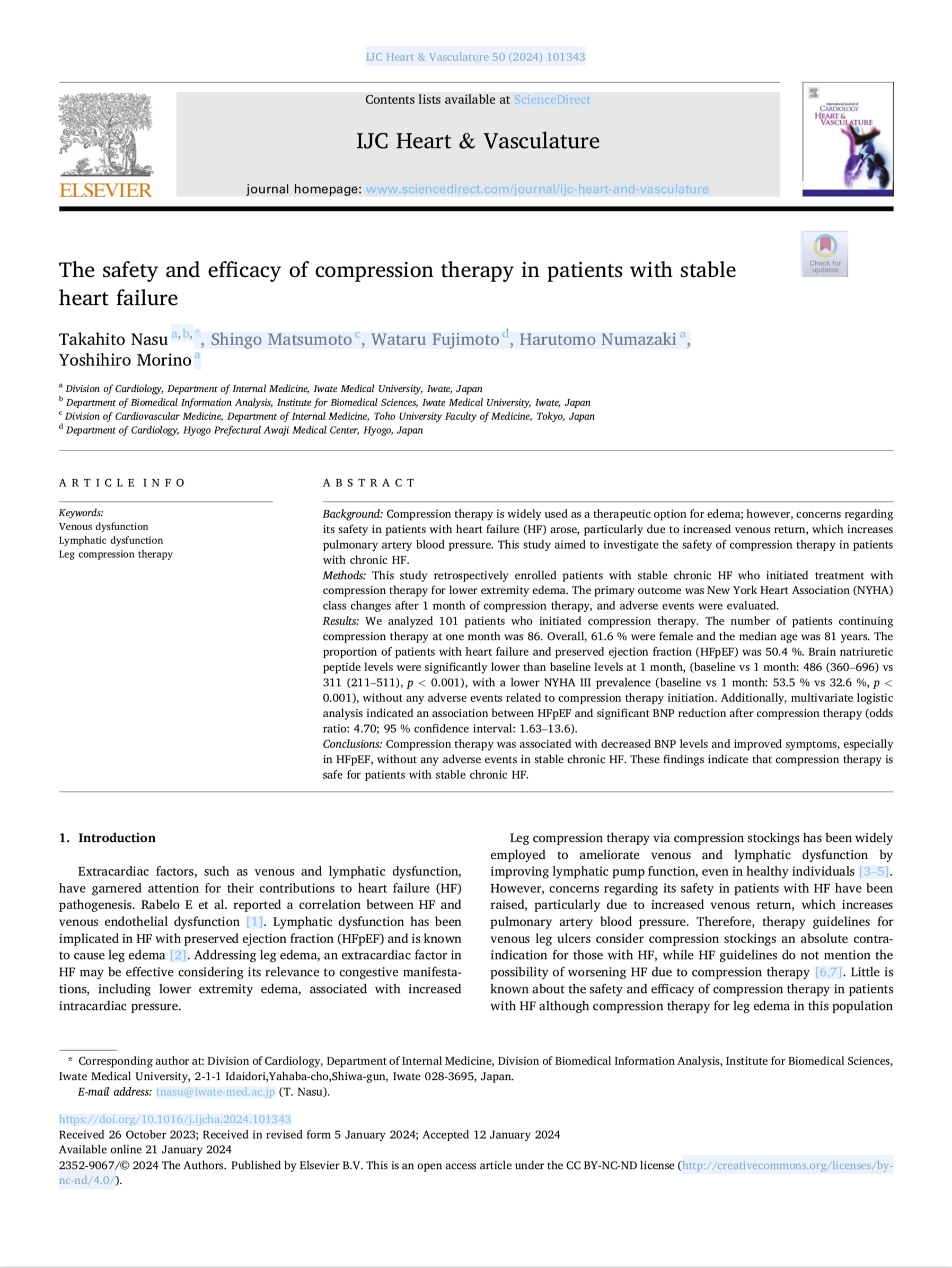The safety and efficacy of compression therapy in patients with stable heart failure
T. Nasu, S. Matsumoto, W. Fujimoto, H. Numazaki and Y. Morino
International journal of cardiology. Heart & vasculature 2024 Vol. 50 Pages 101343-101343

Chronic oedema frequently accompanies heart failure, and practitioners treating lymphoedema often have concerns about applying compression therapy to these patients. This study contributes valuable evidence to the existing knowledge regarding this matter.
Main findings
The study showed that leg compression improved the New York Heart Association classification, reduced Brain Natriuretic Peptide (BNP) levels, and decreased oedema among heart failure (HF) patients after 1 month. BNP is a protein which is made by the heart and blood vessels. Stopping therapy led to increased BNP levels. Multivariate logistic analysis indicated an association between heart failure and preserved ejection fraction (HFpEF) and significant BNP reduction after compression therapy (odds ratio: 4.70; 95 % confidence interval: 1.63–13.6). Complications were minimal, but only half persisted with therapy for 3 months as they didn’t tolerate them. Knowledge gaps remain, calling for more research. Safety concerns include blood displacement and potential pulmonary oedema. Compression increased atrial natriuretic peptide levels temporarily. No adverse events occurred initially, supporting safe use in stable HF patients.
The study found that surgery for varicose veins reduced BNP levels, similar to how compression therapy potentially decreases BNP through improved venous function. It also suggested a connection between lymphatic dysfunction and HFpEF. Compression therapy reduced venous and lymphatic pressures, indicating fluid reduction. A trial on acute HF showed compression therapy led to less diuretic use, reduced oedema, and shorter hospital stays without major complications, supporting its safety. However, limitations include the study’s design, sample size, and patient characteristics call for further research to fully understand compression therapy’s impact on HF.
Maree O’Connor sought further clarification on the research. Dr Takahito Nasu, MD, PhD Division of Cardiology, Department of Internal Medicine. Division of Biomedical Information Analysis, Institute for Biomedical Sciences. Iwate Medical University, Japan was kind enough to respond.
Question:
What were the type of compression stockings the patients wore. This includes:
- Were they below knee or thigh length?
- Were they circular knit or flat knit?
- What was the level of compression i.e. class 1, class 2, class 3?
Answer:
Length of Compression Stockings: All compression stockings used in our study were of below-knee length. We chose this specification to target a broad applicability within the patient population, considering both comfort and efficacy.
Type of Knit: The compression stockings utilized in the research were not restricted to a single type of knit. We included both circular knit and flat knit stockings in our study to reflect the variety commonly available in clinical settings. This approach allowed us to observe outcomes across a more representative sample of the patient population.
Level of Compression: The levels of compression applied in our study were not uniform across all participants but varied according to individual case needs. This variability reflects the personalized approach taken in clinical practice to optimize patient care. However, it also represents a limitation of our study, as the effects of specific compression classes could not be uniformly assessed across the patient cohort.
Question:
Did you find there was a difference in tolerance between circular and flat knit? One thing we find here in Australia is we can reduce the level of compression eg class 1 if we have a flat knit which has more stiffness and also has more shape.
Answer:
In our retrospective study, we did not specifically collect data on the knit type or material properties of the compression stockings used, focusing more on the overall efficacy and safety of compression therapy in elderly patients, many of whom were over 80 years old. The choice of stockings was primarily guided by ease of use and patient comfort, rather than the specifics of knit type or compression class.
Therefore, we unfortunately do not have data on the tolerance differences between circular and flat knit stockings. Your point about the potential benefits of flat knit stockings, even at lower compression classes, is well-taken and highlights an important area for future research.



